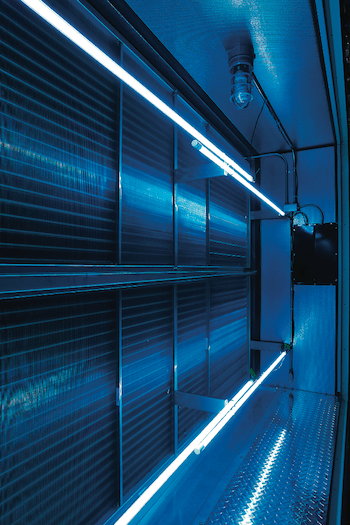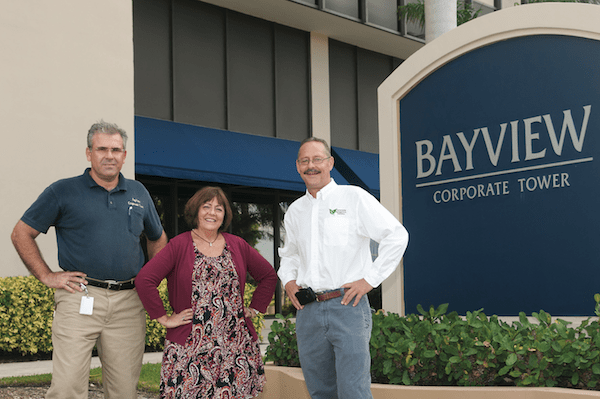When you compete for premier office tenants in a high-rent market like south Florida, your building better have the best finishes and systems to stand out from the competition. That’s an ongoing challenge that motivates Bunnie Willis in her role as Vice President, Senior Property Manager for the 12-story BayView Corporate Tower in Fort Lauderdale. Built in 1973, the 412,000-sq.-ft. Class A building houses 13 corporate tenants, including AT&T, Whole Foods and Landmark Worldwide.

Built in 1973, the 12-story, 412,000-sq.-ft., BayView Corporate Tower in Fort Lauderdale, Fla. recently completed a HVAC system upgrade that significantly improved air quality, slashed energy consumption, and yielded a 3-month return on investment. Project managers overcame limited access to the building’s 25-year-old air handlers and evaporators using a fixtureless ultraviolet-C (UV-C) lamp system from UV Resources.
Willis routinely looks for ways to enhance the value of BayView and the other Florida commercial properties she manages on behalf of New Boston Fund, Inc., a multi-billion-dollar private real estate investment management firm. In July 2011, during a routine evaluation of the BayView Tower’s mechanical systems, Willis learned that she could provide her tenants with cleaner, healthier air by making modest upgrades to the building’s heating, ventilating and air conditioning (HVAC) systems. One such upgrade also held the promise of saving energy, reducing maintenance costs and extending equipment life.
The Use of UV Lighting
A key component in the HVAC system upgrades was the addition of ultraviolet-C (UV-C) lamps. Used extensively since the 1990s to improve indoor air quality (IAQ) and later to improve heat exchange efficiency, boost airflow and reduce maintenance, the UV-C wavelength eliminates, and further prevents, microbial and organic materials buildup on HVAC cooling coils, air filters and duct surfaces and in drain pans.

The UV Resources RLM Xtreme fixtureless UV-C lamp system delivers high-output ultraviolet energy to irradiate coils and destroy mold, bacteria and viruses in demanding and high-volume HVAC environments. Ideal for both new and retrofit applications, the Xtreme lamp system combines the best UV-C components in a simple, flexible and affordable design that’s easily configurable to fit into most any plenum.
However, it is the technology’s ability to potentially slash between 10 to 25 percent of HVAC energy use that drives nine-of-every-10 UV-C installations, says Bruce Fontaine, Vice President of Business Development and Operations at Sustainable Management Solutions, a national energy efficiency consultancy specializing in commercial HVAC, electrical and water use reductions based in Pompano Beach, Fla. Fontaine’s team recommended the sustainable UV-C solution, product selection and installation at BayView.
In the end, an independent audit documented as much as a 47 percent increase in the building’s airflow levels following the UV-C installation, which also reduced enough energy use to pay for the upgrade in just three-months—an impressive 90-day return on investment. The audit not only showed an increase in airflow, but also a reduction in both fan and refrigeration-system energy consumption.
According to the U.S. Department of Energy (DOE), Willis is not alone in targeting HVAC as a potential source of savings, as this equipment accounts for between 30 to 50 percent of a building’s total energy use – a figure that may be even more pronounced in southern climates such as Florida.
Following the recommendation to add UV-C technology to BayView’s air handling units (AHU) Willis, a registered Real Property Administrator and president of the Fort Lauderdale/Palm Beaches chapter of the Building Owners & Managers Association, did her homework learning more about the technology.
Willis met with the building’s Chief Engineer, Miki Minic, who had successfully used UV-C lamp systems in several other buildings managed by New Boston Fund and Stiles Property Management.
“There are many benefits of UV-C,” says Minic, who enthusiastically supported the addition of a UV-C energy install. “Most important is the improvement to indoor air quality levels, so tenants enjoy cleaner, healthier air. Absenteeism due to the spread of unsafe microorganisms via HVAC systems is almost eliminated. Moreover, equipment life is improved, downtime and preventive maintenance expenses like cleaning the coils, drain pans, and the purchase of coil and drain treatments, etc., is significantly reduced.”
BayView’s Willis also visited similar properties in the area with HVAC UV lighting installations and looked to her peers for their input and experience with the technology.
“Following my research and meeting with other commercial property managers who had UV lighting installed, I was sold on the technology’s benefits,” she says.

New Boston Fund property managers achieved a 47 percent increase in HVAC airflow levels by installing a fixtureless UV-C lamp system from UV Resources at BayView Corporate Towers, a 12-story, 412,000 sq. ft., class A commercial office complex in Fort Lauderdale, Fla. Pictured (Left to Right): Miki Minic, chief engineer, BayView Corporate Tower; Bunnie Willis, vice president, senior property manager, New Boston Fund, and Bruce Fontaine, vice president of business development, Sustainable Management Solutions, LLC.
The BayView Installation
With two cooling towers, three chillers and 24 AHUs (two per floor), the UV installation at the BayView Corporate Tower presented some challenges, notes Darren Ambrosi, a project manager with Sustainable Management Solutions.
“The existing AHUs were 25 years old and offered limited access to the evaporators,” says Ambrosi, regarding the retrofit project that began January 2012. “Because of the tight access, we recommended the RLM Xtreme high-output, fixtureless UV-C lamp system from UV Resources. This modern UV-C system installs in about half the time of conventional fixtures and offers flexible configurations such as those required at BayView.”
Minic, the building’s chief engineer, had experience with the RLM Xtreme system and supported the product selection. As a result of the installation flexibility of the fixtureless UV-C lamp system, the retrofits were completed in just four days using only two installers.
Following the UV-C retrofit, efficiency consultant Fontaine was impressed with the boost in system performance.
“The overall transformation in efficiency was incredible,” remarks Fontaine, who estimates that the project energy savings yielded a three-month ROI. “Airflow levels increased by 47 percent in one air handler, or roughly 10,000 CFM, the coils look brand new and the condensate pans cleaned up tremendously.”
ROI Exceeded Expectations
As with any major capital project, return on investment is a critical component that must be independently demonstrated. To evaluate the success of the installation, Willis commissioned an independent performance test by HVAC consultant John Kneiss, president of K & P Mechanical Solutions, Inc., based in Dania, Fla.
“Our goal was to measure the performance of the HVAC system cooling coil before and after the UV fixtures were installed,” Kneiss explains.
During the velocity profile tests conducted prior to the RLM Xtreme installations, Kneiss discovered varying levels of velocity, indicating that some parts of the coil were much dirtier than others.
“It was easy to see certain sections had high velocities and other sections were low, indicating a build-up of debris in the lower velocity areas,” he says. “The velocity readings in our baseline measurements were not stable.”
When Kneiss returned following the installation of the UV lighting system, he used the same test instruments and procedures, and found the air velocity readings to be much more stable, this time, across the entire coil surface.
“Our opinion after reviewing the results and differences was that the cooling coil performance was significantly improved from our first set of readings,” Kneiss recalls. “Coil velocities were more even throughout the coil and there was an improvement of the off coil dew point as well. For us in south Florida, that is a major benefit.”
BayView’s Minic noted increased efficiency of individual HVAC components and a drop in electric consumption overall following the UV-C installation.
As for Willis, she was so pleased with the results that she plans future use of UV-C technology and the RLM-Xtreme.
“Within one month, we saw an immediate reduction in our energy costs, which has remained consistent since the installation,” explains Willis. “I believe so strongly in this improvement that we are getting ready to do it at one of our other properties in Doral, Fla. We are very satisfied with the decision to install the UV lighting.”
PROJECT PROFILE
LOCATION: Fort Lauderdale, Fla.
STRUCTURE: 12-Story, 412,000 sq. ft. Class A office building constructed in 1973
HVAC EQUIPMENT: Two cooling towers, three chillers (250-, 430- and 750-ton) and 24 AHU’s (2 per floor)
FEATURED SYSTEM: RLM Xtreme fixtureless UV-C lamp system, from UV Resources, Santa Clarita, Calif.
UV BENEFITS: The UV germicidal wavelength (UV-C) can reliably provide cleaner, healthier air by preventing microbial buildup in HVACR cooling coils, drain pans, air filter and duct surfaces. UV-C energy also kills pathogens in airstreams. UV-C’s proper application results in improved coil heat – transfer, reduced energy use, less odor, and reduced cleaning downtime and damage. These effects can also lower the incidence of airborne allergies, colds and flu, which could result in lower rates of absenteeism.
ENGINEER: Stiles Corporation, Fort Lauderdale, Fla.
INSTALLATION TIME: Four days, with two installers
PROJECT MANAGER: Sustainable Management Solutions, Pompano Beach, Fla.
COMPLETION DATE: March 2012




Join the conversation: